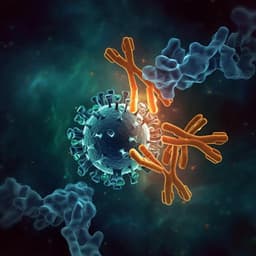
Medicine and Health
Parallel profiling of antigenicity alteration and immune escape of SARS-CoV-2 Omicron and other variants
C. Sun, Y. Kang, et al.
Explore the fascinating evolution of SARS-CoV-2 variants, including Omicron, which have taken immune escape to new heights! This groundbreaking research by Cong Sun and colleagues employs computational interface analysis and in vitro assays to profile critical mutations affecting antibody neutralization. Uncover the insights that guide the future of neutralizing antibody therapy.
~3 min • Beginner • English
Introduction
The COVID-19 pandemic continues to threaten global public health. The SARS-CoV-2 spike (S) protein, particularly its receptor-binding domain (RBD), mediates ACE2 recognition and is the primary target of neutralizing antibodies and vaccines. Mutations in spike can alter antigenicity and facilitate immune escape, undermining vaccine and antibody efficacy and necessitating close surveillance. Variants of concern (VOCs)—Alpha (B.1.1.7), Beta (B.1.351), Gamma (P.1), Delta (B.1.617.2)—and variants of interest (e.g., Kappa B.1.617.1, Lambda C.37) bear key RBD substitutions (K417, L452, E484, N501, T478, F490) associated with increased transmissibility and reduced neutralization. The newly emergent Omicron (B.1.1.529) carries an unprecedented number of spike mutations, including 12 in RBD, raising concerns about antigenic drift. The study’s purpose was to systematically and in parallel profile how these mutations alter antigenicity and neutralization by a panel of monoclonal antibodies, combining computational interface analysis with in vitro kinetics and pseudovirus neutralization, and to evaluate whether computational approaches can support early mutation surveillance and guide antibody therapy.
Literature Review
The introduction synthesizes prior findings that D614G enhanced infectivity and transmissibility and that VOCs with RBD substitutions (N501Y in Alpha; K417N/T, E484K, N501Y in Beta and Gamma; L452R and T478K in Delta; L452Q/E484Q/F490S in Kappa/Lambda) reduce neutralization by vaccine/convalescent sera and some monoclonals. Computational advances (e.g., AlphaFold2, Rosetta-based analyses) have aided structure prediction and evaluation of mutation impacts on protein-protein interfaces and ACE2 binding. Prior studies report E484 as a key escape hotspot, K417 and N501 affecting specific antibody classes, and that antibody cocktails targeting non-overlapping epitopes can improve breadth.
Methodology
Study design: Parallel computational and experimental profiling of spike/RBD mutations from SARS-CoV-2 variants (Alpha, Beta, Gamma, Delta, Kappa, Lambda, Omicron) against a panel of 14 neutralizing antibodies and ACE2.
Computational interface analysis: Co-crystal structures of RBD with antibodies or ACE2 (PDB: 7KZB, 7K45, 7JX3, 7CM4, 6XDG, 7BWJ, 7L5B, 7C01, 7JMW, 6MOJ, 7LON) were relaxed with Rosetta FastRelax (15 models; lowest-energy model selected). Mutations corresponding to variant RBD changes were specified. Flex ddG (Rosetta ensemble-based) generated 35 mutant and WT models via backrub sampling, torsion minimization, and side-chain repacking; average ΔΔG (kcal/mol) was computed to estimate interfacial free-energy changes. Structural inspections compared WT vs mutant lowest-energy models to identify loss of polar contacts and interfacial complementarity.
Constructs and protein production: Spike ectodomains (HexaPro, residues 16–1138) and RBD (319–541) from WT and variants (GISAID accessions listed) were synthesized/codon-optimized. HexaPro incorporated six prolines (F817P, A892P, A899P, A942P, K986P, V987P), GSAS cleavage-site substitution, a flexible linker, and T4 foldon; tags included TPA signal, HRV3C site, 8xHis, Twin-Strep. Spike and hACE2 (residues 19–615) were expressed in Expi293F cells and purified by Ni-affinity and size-exclusion chromatography (PBS pH 7.4).
Antibodies: Heavy/light chains for 14 monoclonals (REGN-10933, Regdanvimab/CT-P59, S2-E12, COVA1-16, S2-H14, S2-M11, CB6, IgG1-ab1, P2B-2F6, CR3022, COV2-2196, 4A8, Fab 2-15, REGN-10987) were cloned, expressed in Expi293F cells, purified by Protein A and SEC.
Cells: HEK293T and ACE2-stable HEK293T (hACE2-HEK293T) maintained under standard conditions; Expi293F for protein expression. Mycoplasma-free verification performed.
Biolayer interferometry (BLI): Protein A biosensors loaded with antibodies (5 mg/L), associated with spike variants across concentration gradients (100 s) and dissociated (200 s). Global 1:1 fits yielded kinetic parameters (KD; reported as -log10 KD). For ACE2, biotinylated hACE2 captured on SA biosensors. Normalized maximum binding signals were measured at 200 nM spike for each antibody.
Pseudovirus production and neutralization: Lentiviral pseudoviruses bearing WT or variant spikes were produced in HEK293T with luciferase reporter (pNL4-3-R-E-luc). hACE2-HEK293T cells were infected in the presence of serially diluted antibodies. IC50 values (log10[µg/mL]) were computed via nonlinear regression based on 50% reduction in luciferase signal. Duplicate experiments were averaged.
Complex assembly and SEC: In vitro assembly of spike with ACE2/antibodies at 3-fold molar excess; complexes assessed by SEC to evaluate stable complex formation.
Data and code: Flex ddG/Rosetta scripts available at https://github.com/bigtaotao/covid_scripts.git; structural visualization by ChimeraX/PyMOL.
Key Findings
- Computational interface analysis (Flex ddG) pinpointed E484 as a dominant escape hotspot: E484K substantially increased interfacial ΔΔG, indicating reduced binding, for multiple antibodies (Regdanvimab +3.0 kcal/mol; P2B-2F6 +3.9; Fab 2-15 +4.2; S2-M11 +3.7). E484A (present in Omicron) also impaired binding (e.g., Regdanvimab +2.4; P2B-2F6 +2.5; Fab 2-15 +3.3; S2-M11 +2.7). F490S (Lambda) produced similar effects.
- N501 and K417 mutations selectively affected specific antibodies: N501Y increased ΔΔG for S2-H14 (+3.6), and Y505H further increased it (+2.1); K417N/T increased ΔΔG for CB6 (+2.1/+1.8). L452R/Q showed modest or context-dependent ΔΔG changes but could destabilize interfaces via polarity/complementarity shifts.
- ACE2 binding was largely unchanged across single mutations and full variant mutation sets (ΔΔG near 0), suggesting selection for preserved infectivity.
- Variant-level Flex ddG indicated broad impacts: Omicron combined E484A and N501Y/Y505H effects leading to large ΔΔG increases for several antibodies (e.g., S2-H14 +10.4; S2-M11 +5.7; Fab 2-15 +3.8; P2B-2F6 +2.6; Regdanvimab +1.9). Beta/Gamma, harboring K417 and E484 changes, showed decreased affinity to CB6 and multiple class 2/3 antibodies.
- Structural analysis rationalized escape mechanisms: mutations disrupted key hydrogen bonds/polar networks—E484 substitutions abolished contacts with P2B-2F6 (R112, Y34), N501Y/Y505H abrogated S2-H14 interactions (RBD N501–LC D108; Y505–HC E51), and K417N/T removed CB6 heavy-chain D104 contact. L452R introduced charge repulsion or polarity mismatch, reducing interfacial complementarity.
- BLI kinetics: Variants with E484 or F490 mutations showed markedly reduced antibody binding affinities; Omicron spike exhibited minimal binding to almost all antibodies by normalized maximum binding signal, with S2-E12 and COV2-2196 least affected. Despite antibody binding losses, ACE2 binding remained comparable to WT across variants.
- Delta showed greater experimental binding reductions for Regdanvimab and P2B-2F6 than Flex ddG predicted, indicating contributions from non-RBD mutations or underestimation by the model.
- Pseudovirus neutralization mirrored binding results: Alpha/Delta were generally neutralized by many antibodies; Beta, Gamma, Kappa, Lambda, and especially Omicron exhibited strong resistance. Only S2-E12 and COV2-2196 retained partial neutralization of Omicron.
- Binding KD alone was not always predictive; maximal binding capacity was a better indicator of antibody effectiveness for some antibodies (e.g., S2-H14, CB6, Regdanvimab), emphasizing the need to assess both KD and saturation.
Discussion
The study demonstrates that specific RBD mutations drive antigenicity alterations which translate into immune escape. Computational interface analysis effectively anticipated mutation-driven losses in antibody binding by quantifying interfacial destabilization, especially for E484, K417, N501/Y505 hotspots. Experimental BLI and pseudovirus assays corroborated these predictions, showing that Omicron exhibits the broadest and strongest escape among tested variants while maintaining ACE2 binding. The findings highlight that preserving receptor binding while disrupting antibody interfaces is a common evolutionary route for SARS-CoV-2. Notably, maximal binding capacity, in addition to KD, critically determines neutralization outcomes for certain antibody-epitope combinations. The heterogeneous sensitivity of antibodies to distinct mutations underscores the value of antibody cocktails targeting non-overlapping epitopes to maintain breadth against emerging variants. Integrating computational screening with targeted in vitro validation provides a practical framework for rapid surveillance of new mutations and prioritization of therapeutic antibodies.
Conclusion
This work provides a parallel computational-experimental profiling of spike RBD mutations across major SARS-CoV-2 variants. It identifies E484 substitutions as primary drivers of broad antibody escape, with K417 and N501/Y505 mediating antibody-specific resistance, and shows that Omicron combines these mechanisms to achieve exceptional immune evasion while retaining ACE2 binding. The study validates computational interface analysis (Flex ddG) as a sensitive, rapid tool to flag concerning mutations and guide antibody selection, complemented by kinetic and neutralization assays that emphasize the importance of maximal binding capacity. Future research should focus on: expanding structural/energetic analyses to include conformational and glycan effects; integrating whole-spike and non-RBD mutations; developing variant-resilient antibody cocktails; and applying high-throughput computational surveillance pipelines for early detection of escape-prone mutations.
Limitations
- Flex ddG accuracy depends on input structure resolution and primarily captures local interfacial changes, potentially missing long-range or conformational effects (e.g., Omicron RBD side mutations G339, R346, S371, S373, S375).
- Non-RBD and combinatorial spike changes can influence binding/neutralization but are not fully accounted for in RBD-centric modeling (e.g., Delta discrepancies for Regdanvimab and P2B-2F6).
- Kinetic KD values can be insufficient to assess functional binding without considering maximal binding capacity; thus, relying solely on KD may misestimate neutralization potential.
- Pseudovirus systems, while informative, may not capture all aspects of live virus infection and in vivo dynamics.
Related Publications
Explore these studies to deepen your understanding of the subject.







